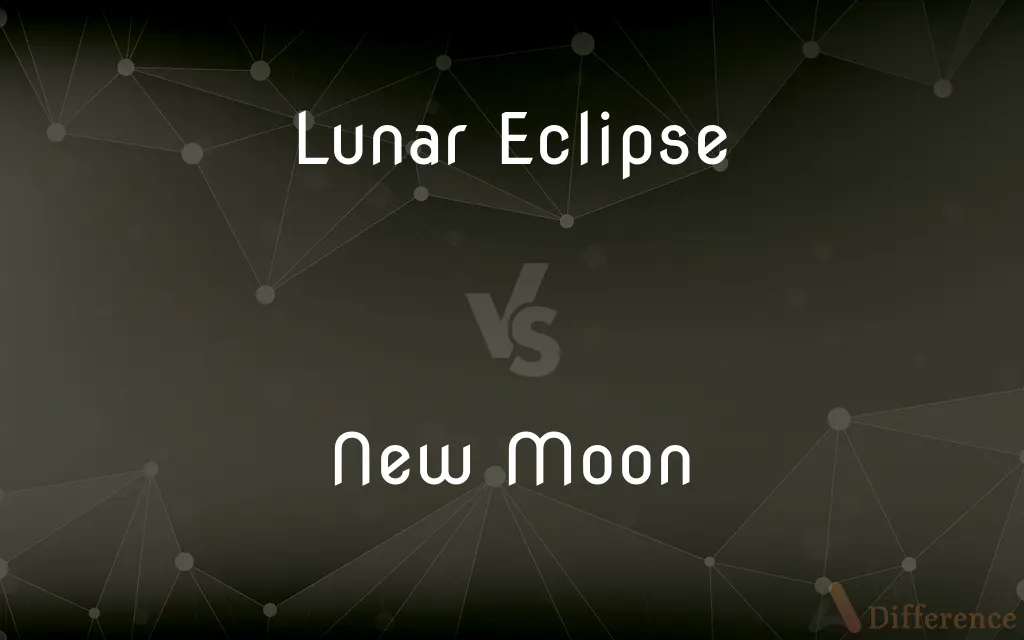Lunar Eclipse vs. New Moon — What's the Difference?
By Tayyaba Rehman — Published on November 16, 2023
Lunar Eclipse is an earth's shadow on the Moon. New Moon is a moon's phase when not visible from Earth.

Difference Between Lunar Eclipse and New Moon
Table of Contents
ADVERTISEMENT
Key Differences
A Lunar Eclipse is a celestial event where the Earth comes between the Sun and the Moon, causing the Earth's shadow to fall on the Moon. On the other hand, a New Moon is a phase of the moon when it is positioned between the Earth and the Sun, rendering it invisible from Earth.
The Lunar Eclipse, which results from the alignment of the Sun, Earth, and Moon, is a relatively rare occurrence, happening only a few times a year. In contrast, the New Moon is a regular monthly event, marking the beginning of the lunar cycle when the moon's face is completely shadowed from Earth's perspective.
During a Lunar Eclipse, observers from Earth can often see the Moon take on a reddish hue, known as a "blood moon," due to Earth's atmosphere bending sunlight onto the Moon. In the case of a New Moon, the moon is not illuminated at all from our perspective, making it practically invisible against the backdrop of the night sky.
Additionally, the duration of visibility differs between the two. A Lunar Eclipse can last for several hours, with the Moon passing through the partial and total phases of the eclipse. The New Moon phase, while lasting for about a day, means the Moon remains invisible or just a very thin crescent for the duration.
Importantly, both events have fascinated humankind for millennia. A Lunar Eclipse, with its dramatic visual transformation, often inspired myths and legends. Meanwhile, the New Moon, marking a fresh lunar cycle, has been used for centuries as a time-marker and has its own set of cultural and spiritual significances.
ADVERTISEMENT
Comparison Chart
Definition
Earth's shadow cast on the Moon.
Moon's phase when it's between Earth and the Sun.
Frequency
Few times a year.
Once a month.
Visibility
Often visible as a reddish moon.
Mostly invisible from Earth.
Duration
Lasts for several hours.
Lasts for about a day.
Cultural Significance
Associated with myths and legends.
Marks a new lunar cycle.
Compare with Definitions
Lunar Eclipse
A dramatic moonlit transformation.
The Lunar Eclipse offered a breathtaking view of the cosmos.
New Moon
A lunar phase of beginnings.
Many cultures celebrate the New Moon as a time of rebirth.
Lunar Eclipse
Earth's umbra on the Moon.
The Lunar Eclipse last night was spectacular!
New Moon
The moon's invisible phase.
During the New Moon, stargazing is at its best due to dark skies.
Lunar Eclipse
When Earth interrupts solar rays.
The Lunar Eclipse is a testament to the precision of celestial mechanics.
New Moon
When Moon aligns with the Sun.
The New Moon is a perfect time to set new intentions.
Lunar Eclipse
A celestial shadow play.
During the Lunar Eclipse, the Moon turned a deep shade of red.
New Moon
A fresh lunar start.
The New Moon marks the beginning of the lunar month.
Lunar Eclipse
Moon's passage through Earth's shadow.
People gathered to watch the Lunar Eclipse, hoping to see the blood moon.
New Moon
The moon's shadowed side.
We couldn't see the Moon last night; it was a New Moon.
Common Curiosities
Why does a Lunar Eclipse turn red?
During a Lunar Eclipse, the Earth's atmosphere bends sunlight onto the Moon, giving it a reddish hue.
Can you see a New Moon?
No, during a New Moon, the Moon is mostly invisible from Earth as its illuminated side faces away.
Are Lunar Eclipses safe to watch?
Yes, Lunar Eclipses are safe to view without any special equipment.
Is a New Moon the same as a dark moon?
Essentially, yes. Both terms describe the Moon's phase when it's not visible from Earth.
Do Lunar Eclipses impact tides differently?
While the Sun and Moon influence tides, a Lunar Eclipse itself doesn't have a significant impact on tidal patterns.
When is the best time for stargazing?
During a New Moon, skies are darkest, making it ideal for stargazing.
How many types of Lunar Eclipses are there?
There are three main types: total, partial, and penumbral.
What causes a Lunar Eclipse?
A Lunar Eclipse occurs when the Earth comes between the Sun and the Moon, casting its shadow on the Moon.
How often does a New Moon occur?
A New Moon happens once a month, marking the start of a new lunar cycle.
How long does a Lunar Eclipse last?
A Lunar Eclipse can last for several hours, including its partial and total phases.
How is the New Moon significant in astrology?
In astrology, the New Moon represents new beginnings and is a time to set intentions.
What's the symbol for a New Moon?
In calendars, a New Moon is often represented by a black or empty circle.
Is the New Moon a phase or an event?
The New Moon is a phase of the moon's cycle.
Why doesn't a Lunar Eclipse happen every full moon?
Because the Moon's orbit is tilted, it doesn't always align perfectly with the Earth and Sun for an eclipse to occur.
Can a Lunar Eclipse happen during a New Moon?
No, a Lunar Eclipse occurs during a full moon when Earth is between the Sun and the Moon.
Share Your Discovery

Previous Comparison
Iced Tea vs. Sweet Tea
Next Comparison
Real Burberry vs. Fake BurberryAuthor Spotlight
Written by
Tayyaba RehmanTayyaba Rehman is a distinguished writer, currently serving as a primary contributor to askdifference.com. As a researcher in semantics and etymology, Tayyaba's passion for the complexity of languages and their distinctions has found a perfect home on the platform. Tayyaba delves into the intricacies of language, distinguishing between commonly confused words and phrases, thereby providing clarity for readers worldwide.











































